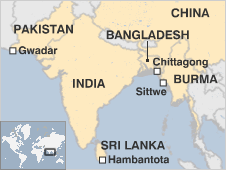Is Chittagong one of China's 'string of pearls'?

From the vast, tropical quayside of Chittagong port, you can see enormous metal tankers bearing down on simple wooden fishing boats. This squalid city has long been Bangladesh's largest port - but it is about to change forever.
"The Chinese have a very good quality of work," says Commodore Riaz. The naval officer is overseeing Chittagong's commercial port as it prepares for a transformation.
Commodore Riaz has an air of discipline and efficiency about him. He values the professionalism of the Chinese contractors whom he recently hired to complete two huge new terminals.
But now the Chinese government is going much further. China has promised to fund the transformation of this coastline, which reports estimate will cost $9bn.
The plans involve an ambitious new deep sea port further along the coast, and a motorway running all the way to China - via neighbouring Burma. For a little country like Bangladesh, any development is good," says Commodore Riaz.
"The time I spent in China was the best time of my life," he adds. As a senior naval officer, Commodore Riaz spent a year training at an elite Beijing military academy.
Both military and civilian aid coming from China is remarkably generous. Beijing has also recently forgiven all loans it made to Bangladesh before 2008.
Chinese 'grand design'
The various forms of Chinese assistance to Bangladesh have caused jitters in India - the huge country next door which some Bangladeshis still call "Big Brother."
Chinese-backed ports in South Asia worry India
India is concerned because a similar story is unfolding in Pakistan, Sri Lanka and in Burma - where China is also building roads and deep sea ports.
Indian defence experts fear that China is surrounding India with ports. They call it China's "string of pearls".
"This is not a fear, this is a fact," says Professor Shrikant Kondapalli of Jawaharlal Nehru University in Delhi.
He believes China is "setting up shop" in smaller countries around the Indian Ocean because of oil. An estimated 80% of oil for China's resource-hungry economy comes from the Middle East and Africa, via the Indian Ocean.
LISTEN TO THE PROGRAMME
Tiger v Dragon, BBC Radio 4, Monday 10 May and 17 May at 2000 BST
Or listen again via the BBC iPlayer
Rapidly-growing India also needs oil, and it stands directly in the middle of China's supply route.
The Indians fear that although these deep sea ports will be for trade, China could call them in for military or strategic purposes if oil becomes scarce.
"When you put together all these jigsaw puzzles it becomes clear that Chinese focus in Indian Ocean is not just for trade," says Professor Kondapalli. "It is a grand design for the 21st Century."
'Indian paranoia'
In Beijing, India's fears are given short shrift. "During peace time, these kinds of facilities are only for commercial purposes," says Hu Sisheng, head of South Asia policy at the China Institute for Contemporary International Relations.
About 20 years ago, China was also a very poor country - but now it is developing
Chinese engineer Shar Wei
It's a tightly guarded government-run facility in Beijing which analyses foreign affairs and directly advises China's leaders.
China is keen to reassure the world that it has no hostile intent. Mr Hu says the Indians are being paranoid when they talk of a "string of pearls".
"It was minted by a young Pentagon guy," he points out.
The phrase "string of pearls" to describe China's strategy for building ports was originally used by analysts working for the US Department of Defense.
Mr Hu believes Washington is playing games and trying to cosy up to India, as it becomes increasingly concerned about China's rise.
Bangladesh is also adamant that there is nothing in its plans to concern India. "I don't believe if China helps us build this sea port, that China will be able to use it for other purposes," I'm told by Dr Dipu Moni, Bangladesh's foreign minister.
Bangladesh wants to be seen as a "bridge" from China to India, and is careful not to offend either of its giant neighbours.
"Bangladesh will never let any part of its territory be used for any kind of attacks or anything like that," she says.
The bridge is a symbol of a new era in Chittagong
Impoverished Bangladesh is hoping to capitalise on its location between China and India to develop its economy. I see the remarkable impact for myself on the outskirts of Chittagong.
I am stunned when a single track road surrounded by slums suddenly turns into a four-lane motorway. It then crosses a suspension bridge built of gleaming white concrete.
The funds for this bridge came from a Gulf country, and a Chinese firm has done the work.
Next to the bridge, I meet Shar Wei - the project's 28-year-old chief engineer. He left his native city of Wuhan in China to spend three years living in a prefabricated building in the Bangladeshi heat.
"You know, about 20 years ago, China was also a very poor country," he says. "But now it is developing."
He hopes his new bridge, and the Chinese-built port, will help Bangladesh benefit from China's boom. "I think it will also happen in Bangladesh," he says.


